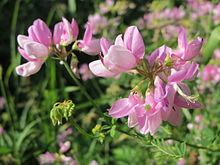Securigera varia
| Crownvetch | |
|---|---|

| |
| Crownvetch in bloom | |
| Scientific classification | |
| Kingdom: | Plantae |
| Clade: | Tracheophytes |
| Clade: | Angiosperms |
| Clade: | Eudicots |
| Clade: | Rosids |
| Order: | Fabales |
| Family: | Fabaceae |
| Subfamily: | Faboideae |
| Genus: | Securigera |
| Species: | S. varia
|
| Binomial name | |
| Securigera varia | |
| Synonyms[1] | |
| |
Securigera varia (synonym Coronilla varia), commonly known as crownvetch[2] or purple crown vetch, is a low-growing legume vine. It is native to Africa, Asia and Europe and is commonly used throughout the United States and Canada for erosion control, roadside planting and soil rehabilitation. It has become an invasive species in many states of the US.
Crownvetch grows 1 to 2 feet (0.30 to 0.61 m) feet tall and bears small clusters of 1⁄2 inch (13 mm) pink and white flowers from early summer to late fall. The variety Penngift produces mounds of pink flowers. Crownvetch is a tough, aggressive spreading plant that will crowd out its neighbors in a show garden but is well suited to a sunny bank, where it will grow for decades with little to no fertilizing, mowing, or weeding since the thick foliage prevents weeds from growing amid it.[3] Its deep, tenacious, complex root system[4] and thick, fern-like leaves provide excellent erosion control where it is used as a ground cover. However, this legume has a very long germination period of about 6 months and does not create full coverage until two or three years later.[4]
Taxonomy
[edit]Securigera varia was given its first scientific description in 1753 by Carl Linnaeus with the name Coronilla varia. In 1989 Per Lassen proposed moving it to the genus Securigera,[5] which had been created by Augustin Pyramus de Candolle in 1805.[6]
As of 2024[update] the correct classification of the species is uncertain. In databases like Plants of the World Online,[5] World Flora Online,[7] and the Legume Data Portal,[8] Coronilla varia is listed as the accepted name. On the other hand Securigera varia is listed as the accepted name in resources such as Flora of the Southeastern United States,[9] World Plants,[10] and the New Zealand Organisms Register.[11]
Forage
[edit]Crownvetch is toxic to horses and other non-ruminants because of the presence of nitroglycosides. If consumed in large amounts, it can stunt growth, or even lead paralysis and death. However, this is not true for ruminant animals such as cattle, goats, and sheep.[12] These aliphatic nitro compounds are degraded in ruminant digestion and do not affect the animals.[12]
Crownvetch was originally labeled as a poor forage for farm animals but more recently it has been deemed as a good forage when fed as hay to or grazed by ruminants.[13] It consists of 21.7% crude protein and 22.2% crude fibre.[14] In an experiment involving the digestibility of crownvetch in sheep, it was found that the crude protein is 65.6% and the crude fibre is 46.2% digestible which is similar, but slightly less than the digestibility of alfalfa forage.[14] As previously mentioned, this only applies to ruminant animals as it is toxic to non-ruminants.[12]
Crownvetch has been identified as an invasive in several midwestern states. It is very hard to eradicate once established.[15]
It is also a common host-plant for the moth Zygaena ephialtes.[16]
Gallery
[edit]-
Crownvetch
-
Crownvetch planted to prevent erosion
-
A field with crownvetch
References
[edit]- ^ a b "Securigera varia", The Plant List, retrieved 2014-10-27
- ^ NRCS. "Securigera varia". PLANTS Database. United States Department of Agriculture (USDA). Retrieved 8 November 2015.
- ^ "Crownvetch". OSC Seeds. (n.d.). Archived from the original on 2014-12-05. Retrieved 2014-11-27.
- ^ a b Gustine, D. L., & Moyer, B. G. (1990). Crownvetch (Coronilla varia L.). In Legumes and Oilseed Crops I (pp. 341-354). Springer Berlin Heidelberg.
- ^ a b "Coronilla varia L." Plants of the World Online. Royal Botanic Gardens, Kew. Retrieved 3 May 2024.
- ^ "Securigera DC". Plants of the World Online. Royal Botanic Gardens, Kew. Retrieved 3 May 2024.
- ^ "Coronilla varia L." World Flora Online. Retrieved 3 May 2024.
- ^ "Coronilla varia L." Legume Data Portal. Legume Phylogeny Working Group (LPWG). Retrieved 3 May 2024.
- ^ Weakley, A.S.; Southeastern Flora Team (2024). "Securigera varia detail". Flora of the Southeastern United States (FSUS). Retrieved 3 May 2024.
- ^ Hassler, Michael (17 April 2024). "Synonymic Checklist and Distribution of the World Flora. Version 19.2". World Plants. Retrieved 3 May 2024.
- ^ New Zealand Organisms Register (2024). "NZOR Name Details - Securigera varia (L.) Lassen". NZOR. Retrieved 3 May 2024.
- ^ a b c Moyer, BG; Gustine, DL (1984). "Regeneration of Coronilla varia L. (crownvetch) plants from callus culture". Journal of Plant Biotechnology. 3 (2): 143–148. doi:10.1007/BF00033735. S2CID 26268447.
- ^ Burns JC, Cope WA. 1974. Nutritive Value of Crownvetch Forage as Influenced by Structural Constituents and Phenolic and Tannin Compounds. Agronomy Journal, 66, p 195-200. Retrieved from https://www.agronomy.org/publications/aj/abstracts/66/2/AJ0660020195
- ^ a b Reynolds PJ, Jackson C, Lindahl IL, Henson PR. 1967. Consumption and Digestibility of Crownvetch (Coronilla varia L.) Forage by Sheep. Agronomy Journal, 59, p 589-591. Retrieved from https://dl.sciencesocieties.org/publications/aj/abstracts/59/6/AJ0590060589
- ^ Indiana Dept of Natural Resources
- ^ "Habitat requirements of conspicuous burnet moth Zygaena ephialtes (Linnaeus, 1767; Lepidoptera: Zygaenidae) (PDF Download Available)". ResearchGate. Retrieved 2017-11-16.
External links
[edit]- Bibliography[permanent dead link]
- Purdue University [1]



